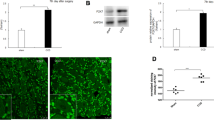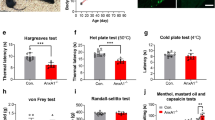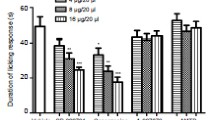Abstract
Background
In the present study we determined the role of transient receptor potential V1 channel (TRPV1) and acid-sensing ion channel 3 (ASIC3) in chronic nociception.
Methods
1% formalin was used to produce long-lasting secondary allodynia and hyperalgesia in rats. Western blot was used to determine TRPV1 and ASIC3 expression in dorsal root ganglia.
Results
Peripheral ipsilateral, but not contralateral, pre-treatment (−10 min) with the TRPV1 receptor antagonists capsazepine (0.03–0.3 μM/paw) and A-784168 (0.01–1 μM/paw) prevented 1% formalin-induced secondary mechanical allodynia and hyperalgesia in the ipsilateral and contralateral paws. Likewise, peripheral ipsilateral, but not contralateral, pre-treatment with the non-selective and selective ASIC3 blocker benzamil (0.1–10 μM/paw) and APETx2 (0.02–2 μM/paw), respectively, prevented 1% formalin-induced secondary mechanical allodynia and hyperalgesia in both paws. Peripheral ipsilateral post-treatment (day 6 after formalin injection) with capsazepine (0.03–0.3 μM/paw) and A-784168 (0.01–1 μM/paw) reversed 1% formalin-induced secondary mechanical allodynia and hyperalgesia in both paws. In addition, peripheral ipsilateral post-treatment with benzamil (0.1–10 μM/paw) and APETx2 (0.02–2 μM/paw), respectively, reversed 1% formalin-induced secondary mechanical allodynia and hyperalgesia in both paws. TRPV1 and ASIC3 proteins were expressed in dorsal root ganglion in normal conditions, and 1% formalin injection increased expression of both proteins in this location at 1 and 6 days compared to naive rats.
Conclusions
Data suggest that TRPV1 and ASIC3 participate in the development and maintenance of long-lasting secondary allodynia and hyperalgesia induced by formalin in rats. The use of TRPV1 and ASIC3 antagonists by peripheral administration could prove useful to treat chronic pain.
Similar content being viewed by others
Abbreviations
- ANOVA:
-
analysis of variance
- ASICs:
-
acid-sensing ion channels
- ASIC1a:
-
acid-sensing ion channel 1a
- ASIC2:
-
acid-sensing ion channel 2
- ASIC3:
-
acid-sensing ion channel 3
- A-784168:
-
(1-[3-(trifluoromethyl)pyridin-2-yl]-N-[4-(trifluoromethylsulfonyl)phenyl]-1,2,3,6-tetrahydropyridine-4-carboxamide
- Bemzamil:
-
(N-(benzylamidino)-3,5-diamino-6-chloropyrazinecarboxamide hydrochloride hydrate
- CGRP:
-
calcitonin gene-related peptide
- PAGE:
-
polyacrylamide gel electrophoresis
- PVDF:
-
polyvinylidene difluoride membranes
- TRPV1:
-
transient receptor potential V1 channel
References
Woolf CJ, Costigan M. Transcriptional and posttranslational plasticity and the generation of inflammatory pain. Proc Natl Acad Sci USA 1999;96:7723–30.
Waldmann R, Champigny G, Bassilana F, Heurteaux C, Lazdunski M. A protongated cation channel involved in acid-sensing. Nature 1997;386:173–7.
Mamet J, Baron A, Lazdunski M, Voilley N. Proinflammatory mediators, stimulators of sensory neuron excitability via the expression of acid-sensing ion channels. J Neurosci 2002;22:10662–70.
Duan B, Wu LJ, Yu YQ, Ding Y, Jing L, Xu L, et al. Upregulation of acid-sensing ion channel ASIC1a in spinal dorsal horn neurons contributes to inflammatory pain hypersensitivity. J Neurosci 2007;27:11139–48.
Ferreira J, Santos AR, Calixto JB. Antinociception produced by systemic, spinal and supraspinal administration of amiloride in mice. Life Sci 1999;65:1059–66.
Jones NG, Slater R, Cadiou H, McNaughton P, McMahon SB. Acid-induced pain and its modulation in humans. J Neurosci 2004;24:10974–79.
Sluka KA, Price MP, Breese NM, Stucky CL, Wemmie JA, Welsh MJ. Chronic hyperalgesia induced by repeated acid injections in muscle is abolished by the loss of ASIC3, but not ASIC1. Pain 2003;106:229–39.
Caterina MJ, Julius D. The vanilloid receptor: a molecular gateway to the pain pathway. Ann Rev Neurosci 2001;24:487–517.
Caterina MJ, Schumacher MA, Tominaga M, Rosen TA, Levine JD, Julius D. The capsaicin receptor: a heat-activated ion channel in the pain pathway. Nature 1997;389:816–24.
Ohta T, Ikemi Y, Murakami M, Imagawa T, Otsuguro K, Ito S. Potentiation of transient receptor potential V1 functions by the activation of metabotropic 5-HT receptors in rat primary sensory neurons. J Physiol 2006;576:809–22.
Loyd DR, Weiss G, Henry MA, Hargreaves KM. Serotonin increases the functional activity of capsaicin-sensitive rat trigeminal nociceptors via peripheral serotonin receptors. Pain 2011;152:2267–76.
Zimmermann M. Ethical guidelines for investigations of experimental pain in conscious animals. Pain 1983;16:109–10.
Ambriz-Tututi M, Rocha-González HI, Castaneda-Corral G, Araiza-Saldana CI, Caram-Salas NL, Cruz SL, et al. Role of opioid receptors in the reduction of formalin-induced secondary allodynia and hyperalgesia in rats. Eur J Pharmacol 2009;619:25–32.
Fu KY, Light AR, Maixner W. Long-lasting inflammation and long-term hyperalgesia after subcutaneous formalin injection into the rat hindpaw. J Pain 2001;2:2–11.
Valencia-de Ita S, Lawand NB, Lin Q, Castaneda-Hernández G, Willis WD. Role of the Na+–K+–2Cl− cotransporter in the development of capsaicin-induced neurogenic inflammation. J Neurophysiol 2006;95:3553–61.
Kanai Y, Hara T, Imai A. Participation of the spinal TRPV1 receptors in formalin-evoked pain transduction: a study using a selective TRPV1 antagonist, iodoresiniferatoxin. J Pharm Pharmacol 2006;58:489–93.
Cui M, Honore P, Zhong C, Gauvin D, Mikusa J, Hernandez G, et al. TRPV1 receptors in the CNS play a key role in broad-spectrum analgesia of TRPV1 antagonists. J Neurosci 2006;26:9385–93.
Mills CD, Nguyen T, Tanga FY, Zhong C, Gauvin DM, Mikusa J, et al. Characterization of nerve growth factor-induced mechanical and thermal hypersensitivity in rats. Eur J Pain 2013;17:469–79.
Quiding H, Jonzon B, Svensson O, Webster L, Reimfelt A, Karin A, et al. TRPV1 antagonistic analgesic effect: a randomized study of AZD1386 in pain after third molar extraction. Pain 2013;154:808–12.
Watabiki T, Kiso T, Tsukamoto M, Aoki T, Matsuoka N. Intrathecal administration of AS1928370, a transient receptor potential vanilloid 1 antagonist, attenuates mechanical allodynia in a mouse model of neuropathic pain. Biol Pharm Bull 2011;34:1105–8.
Schwartz ES, La JH, Scheff NN, Davis BM, Albers KM, Gebhart GF. TRPV1 and TRPA1 antagonists prevent the transition of acute to chronic inflammation and pain in chronic pancreatitis. J Neurosci 2013;33:5603–11.
Shields SD, Cavanaugh DJ, Lee H, Anderson DJ, Basbaum AI. Pain behavior in the formalin test persists after ablation of the great majority of C-fiber nociceptors. Pain 2010;151:422–9.
Tsujino HI, Kondo E, Fukuoka T, Dai Y, Tokunaga A, Miki K, et al. Activating transcription factor 3 (ATF3) induction by axotomy in sensory and motoneurons: a novel neuronal marker of nerve injury. Mol Cell Neurosci 2000;15:170–82.
Page AJ, Brierley SM, Martin CM, Hughes PA, Blackshaw LA. Acid sensing ion channels 2 and 3 are required for inhibition of visceral nociceptors by benzamil. Pain 2007;133:150–60.
Diochot S, Baron A, Rash LD, Deval E, Escoubas P, Scarzello S, et al. A new sea anemone peptide, APETx2, inhibits ASIC3, a major acid-sensitive channel in sensory neurons. EMBO J 2004;23:1516–25.
Grinstein S, Rothstein A. Mechanisms of regulation of the Na+/H+ exchanger. J Membr Biol 1986;90:1–12.
Frelin C, Barbry P, Vigne P, Chassande O, Cragoe Jr EJ, Lazdunski M. Amiloride and its analogs as tools to inhibit Na+ transport via the Na+ channel, the Na+/H+ antiport and the Na+/Ca2+ exchanger. Biochimie 1988;70:1285–90.
Reithmeier RA. Mammalian exchangers and co-transporters. Curr Opin Cell Biol 1994;6:583–94.
Castañeda-Corral G, Rocha-González HI, Araiza-Saldaña CI, Vidal-Cantú GC, Jiménez-Andrade JM, Murbartián J, et al. Blockade of peripheral and spinal Na+/H+ exchanger increases formalin-induced long-lasting mechanical allodynia and hyperalgesia in rats. Brain Res 2012;1475:19–30.
Izumi M, Ikeuchi M, Ji Q, Tani T. Local ASIC3 modulates pain and disease progression in a rat model of osteoarthritis. J Biomed Sci 2012;19:77.
Staniland AA, McMahon SB. Mice lacking acid-sensing ion channels (ASIC) 1 or 2, but not ASIC3, show increased pain behaviour in the formalin test. Eur J Pain 2009;13:554–63.
Ikeuchi M, Kolker SJ, Sluka KA. Acid-sensing ion channel 3 expression in mouse knee joint afferents and effects of carrageenan-induced arthritis. J Pain 2009;10:336–42.
Walder RY, Rasmussen LA, Rainier JD, Light AR, Wemmie JA, Sluka KA. ASIC1 and ASIC3 play different roles in the development of hyperalgesia after inflammatory muscle injury. J Pain 2010;11:210–8.
Chen WH, Tzen JT, Hsieh CL, Chen YH, Lin TJ, Chen SY, et al. Attenuation of TRPV1 and TRPV4 expression and function in mouse inflammatory pain models using electroacupuncture. Evid Based Complement Alternat Med 2012;2012:636848.
Yu L, Yang F, Luo H, Liu FY, Han JS, Xing GG, et al. The role of TRPV1 in different subtypes of dorsal root ganglion neurons in rat chronic inflammatory nociception induced by complete Freund’s adjuvant. Mol Pain 2008;4:61.
Chen WH, Hsieh CL, Huang CP, Lin TJ, Tzen JT, Ho TY, et al. Acid-sensing ion channel 3 mediates peripheral anti-hyperalgesia effects of acupuncture in mice inflammatory pain. J Biomed Sci 2011;18:82.
Huang D, Yu B. The mirror-image pain: an uncleared phenomenon and its possible mechanism. Neurosci Biobehav Rev 2010;34:528–32.
Schreiber KL, Beitz AJ, Wilcox GL. Activation of spinal microglia in a murine model of peripheral inflammation-induced, long-lasting contralateral allodynia. Neurosci Lett 2008;440:63–7.
Wieseler-Frank J, Maier SF, Watkins LR. Central proinflammatory cytokines and pain enhancement. Neurosignals 2005;14:166–74.
Nakanishi M, Hata K, Nagayama T, Sakurai T, Nishisho T, Wakabayashi H, et al. Acid activation of Trpv1 leads to an up-regulation of calcitonin gene-related peptide expression in dorsal root ganglion neurons via the CaMK–CREB cascade: a potential mechanism of inflammatory pain. Mol Biol Cell 2010;21:2568–77.
Kajihara Y, Murakami M, Imagawa T, Otsuguro K, Ito S, Ohta T. Histamine potentiates acid-induced responses mediating transient receptor potential V1 in mouse primary sensory neurons. Neuroscience 2010;166:292–304.
Author information
Authors and Affiliations
Corresponding author
Rights and permissions
About this article
Cite this article
Martínez-Rojas, V.A., Barragán-Iglesias, P., Rocha-González, H.I. et al. Role of TRPV1 and ASIC3 in formalin-induced secondary allodynia and hyperalgesia. Pharmacol. Rep 66, 964–971 (2014). https://doi.org/10.1016/j.pharep.2014.06.011
Received:
Revised:
Accepted:
Published:
Issue Date:
DOI: https://doi.org/10.1016/j.pharep.2014.06.011




